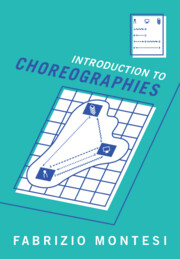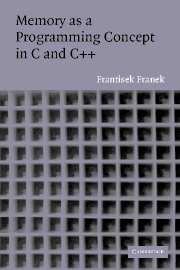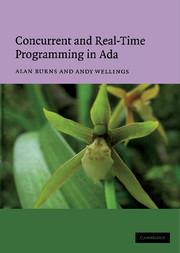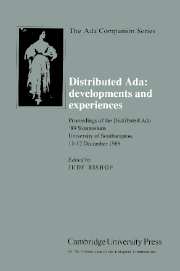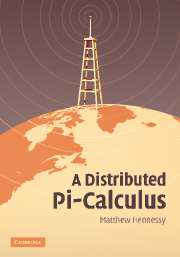Introduction to Choreographies
- Author: Fabrizio Montesi, University of Southern Denmark
- Date Published: May 2023
- availability: Not yet published - available from October 2024
- format: Hardback
- isbn: 9781108833769
$
64.99
Hardback
Other available formats:
eBook
Looking for an inspection copy?
This title is not currently available for inspection. However, if you are interested in the title for your course we can consider offering an inspection copy. To register your interest please contact [email protected] providing details of the course you are teaching.
-
In concurrent and distributed systems, processes can complete tasks together by playing their parts in a joint plan. The plan, or protocol, can be written as a choreography: a formal description of overall behaviour that processes should collaborate to implement, like authenticating a user or purchasing an item online. Formality brings clarity, but not only that. Choreographies can contribute to important safety and liveness properties. This book is an ideal introduction to theory of choreographies for students, researchers, and professionals in computer science and applied mathematics. It covers languages for writing choreographies and their semantics, and principles for implementing choreographies correctly. The text treats the study of choreographies as a discipline in its own right, following a systematic approach that starts from simple foundations and proceeds to more advanced features in incremental steps. Each chapter includes examples and exercises aimed at helping with understanding the theory and its relation to practice.
Read more- Starts by explaining the key aspects of the theory before moving on to more sophisticated features
- Contains numerous examples inspired by practice, demonstrating how to use choreographies to model practical scenarios
- Discusses relevant alternative designs and theoretical issues, exploring the motivation for design choices and teaching how to recognise when a method doesn't work
- Based on established familiar methods from concurrency theory, logic, and programming languages
- Includes an extended discussion on applications and further developments of the approach to inspire further reading and research
Reviews & endorsements
'Distributed Systems have a large number and variety of Computing infrastructure parts. One of the main challenges lies in the solid definition of concurrency and protocols. This excellent and timely book addresses these issues in a convincing way by taking the reader on a journey of dealing with and reasoning on choreographies by providing many examples.' Schahram Dustdar, TU Wien, Austria
See more reviews'A mass of dancers dance individually and concurrently following a choreography, creating a masterpiece collaboratively. Choreographies are a framework to promote a protocol-guided programming for no single point of failure. Montesi's book starts from a friendly introduction to formal methods for beginners and covers comprehensive choreography theories—from the simple choreographies to the advanced extensions. Highly recommended for the undergraduate and graduate computer science students as well as developers of web services.' Nobuko Yoshida, Christopher Strachey Chair of Computing, University of Oxford
'Distributed systems are the norm today. Choreographies govern how autonomous parts of distributed systems that operate concurrently may communicate with each other. However, it is not always clear whether all communication participants comply with a given choreography design. This book comes to the remedy. Fabrizio Montesi, pioneer of choreographic programming with the Jolie language and microservices community leader, establishes a uniform theory and a notation for choreographies – not only to specify their protocols, but also to check participant conformance and prove desired properties including communication safety and freedom from starvation. Read this book if you want to learn or teach these concepts en route to more robust and more understandable Distributed Systems, and apply its concepts in practice if you want to prove that your language, middleware, and tool creations work as designed.' Olaf Zimmermann, Eastern Switzerland University of Applied Sciences, School of Computer Science, Author of Patterns for API Design - Simplifying Integration with Loosely Coupled Message Exchanges
Customer reviews
Not yet reviewed
Be the first to review
Review was not posted due to profanity
×Product details
- Date Published: May 2023
- format: Hardback
- isbn: 9781108833769
- length: 253 pages
- dimensions: 262 x 184 x 19 mm
- weight: 0.63kg
- availability: Not yet published - available from October 2024
Table of Contents
Introduction: Alice, Bob, concurrency, and distribution
This book
Part I. Foundations: Introduction to Part I
1. Inference systems
2. Simple choreographies
3. Simple processes
4. Endpoint projection
Part II. Computation: Introduction to Part II
5. Memory and local computation
6. Conditionals and knowledge of choice
7. Recursion
8. Properties of choreographies and endpoint projection
Part III. Extensions and Variations: Introduction to Part III
9. Conservative extensions
10. Choreographic choice
11. Asynchronous communication
12. Discussion and further reading
Solutions to selected exercises
Bibliography
Index.-
General Resources
Find resources associated with this title
Type Name Unlocked * Format Size Showing of
This title is supported by one or more locked resources. Access to locked resources is granted exclusively by Cambridge University Press to lecturers whose faculty status has been verified. To gain access to locked resources, lecturers should sign in to or register for a Cambridge user account.
Please use locked resources responsibly and exercise your professional discretion when choosing how you share these materials with your students. Other lecturers may wish to use locked resources for assessment purposes and their usefulness is undermined when the source files (for example, solution manuals or test banks) are shared online or via social networks.
Supplementary resources are subject to copyright. Lecturers are permitted to view, print or download these resources for use in their teaching, but may not change them or use them for commercial gain.
If you are having problems accessing these resources please contact [email protected].
Sorry, this resource is locked
Please register or sign in to request access. If you are having problems accessing these resources please email [email protected]
Register Sign in» Proceed
You are now leaving the Cambridge University Press website. Your eBook purchase and download will be completed by our partner www.ebooks.com. Please see the permission section of the www.ebooks.com catalogue page for details of the print & copy limits on our eBooks.
Continue ×Are you sure you want to delete your account?
This cannot be undone.
Thank you for your feedback which will help us improve our service.
If you requested a response, we will make sure to get back to you shortly.
×
